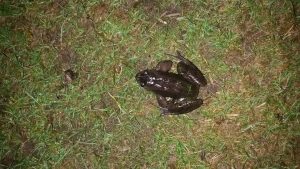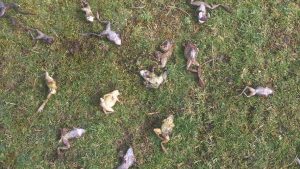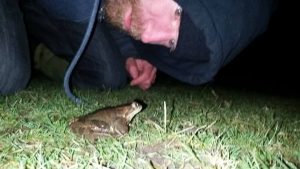Just over a year ago the Herpetological Society of Ireland (HSI) was called out to a site in Kildare where hundreds of common frogs were lying dead. Thankfully, one year on things seem to have improved, but the exact cause of the mass mortality remains a mystery… Rob O’Sullivan, PR Officer with the HSI explains.

On the 24th of February last year, The Herpetological Society of Ireland (H.S.I) were contacted regarding a mass die-off of common frogs (Rana temporaria) at a breeding pool near the Curragh, Kildare. Naturally we were very concerned, especially considering the precipitous decline of amphibian populations worldwide. Thankfully, we were able to quickly dispatch our Science team, led by Robert Gandola, to investigate.
What we found was very distressing; hundreds of frogs were lying dead, or dying, within 3m of the water body. The symptoms displayed by the animals were an additional cause for concern, with the primary affliction being dry and cracked skin, particularly in the neck region. A few specimens displayed symptoms such as patches of red discolouration and areas of focal necrosis (small patches of dead tissue), while others displayed no external symptoms beyond death or lethargy.

The early stages of an investigation such as this will involve a process of elimination, and as such, we considered all possibilities. While the cause of death was not immediately apparent, our primary concern was for the possibility that this was an outbreak of a disease such as Chytridiomycosis or Ranavirus. We took skin swabs of the animals and sent them to the Zoological Society of London to test for the presence of these diseases. Thankfully, the tests came back negative.
Pollution within the breeding pond was another likely candidate, so we immediately performed a water quality analysis, but found nothing out of the ordinary. Post mortems performed on the animals revealed some evidence of a mass predation event, similar to crow attacks seen elsewhere in Europe, and our ongoing investigation is focusing heavily on this possibility.

As a protected species, it is absolutely vital that any threats to the common frog be identified and dealt with as soon as they emerge, particularly in the light of the catastrophic collapse of amphibian populations worldwide. We have performed several follow up investigations of the site and thankfully, to date, we have not found any additional cause for concern. In fact, just this week, we were delighted to discover that the pond was teeming with amphibian life following the onset of the breeding season. In addition to a significant number of breeding frogs, we also found a handful of eager smooth newts (Lissotriton vulgaris) making an early start on their own breeding season.
While these signs are very encouraging, further vigilance is required. We are using every tool at our disposal to continue monitoring this habitat, and we hope to definitively confirm the cause of the mass-mortality event in the very near future. Amphibians face an overwhelming number of threats globally, and while we have been lucky in Ireland in many regards, we cannot afford to be complacent in the face of these threats. We must continue to monitor the health of Ireland’s amphibians and be alert to the first signs of trouble. There is no better way to achieve this goal than to learn to appreciate these wonderful animals, and the habitats they reside in.
We encourage everyone to get out and visit your local waterbodies in the coming weeks, and to keep an eye out for these spectacular breeding events. These animals are an iconic element of Ireland’s natural heritage, and the sight of frogs breeding has been a harbinger of spring for every generation of human to call this island home. Let’s work to ensure future generations are not deprived of this tremendous privilege.
The Herpetological Society Of Ireland encourages anyone who observes suspicious die-offs, to contact us immediately at [email protected] so that we can perform an investigation. Take note of the date, the location and anything noteworthy in the general area. If you can take photos safely and without disturbing wildlife this would also be beneficial. As with any potentially infectious site. we would encourage the public to use caution and disinfect footwear after encountering such an event to reduce the risk that they will inadvertently spread pathogens to another habitat









2 comments
Clare
Could a lightning strike on the pond have caused it?
amanda
What about the wanton destruction of spawning areas by Coillte every year?? I have been into my local office with a map of spawning areas in my local plantation, and had a great chat to the forestry manager about the importance of protecting these ponds, and upon checking the areas later have been heartbroken to find them deliberately destroyed by the driving of logging machines through them (other access available) and the placing of logpiles in them (other areas available in very close proximity) and the spilling of fuel into the water….how do l stop this??? 089 238 5326.